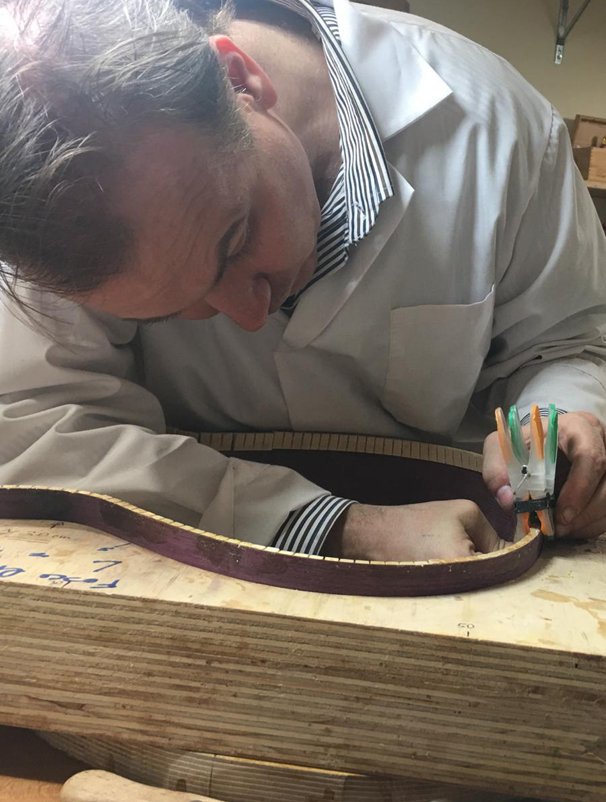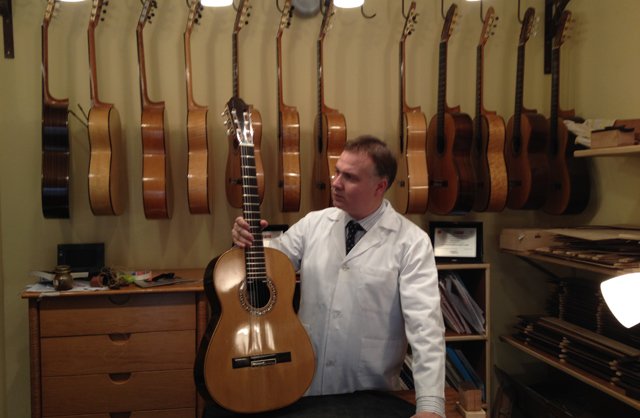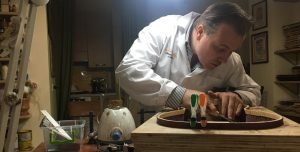Biografia
Laureato in ingegneria
elettronica alla Cockerll
University School of
Engineering di Austin
(Texas) con una tesi
intitolata “Studio
dell’acustica come
fenomeno fisico, psichico
e sue applicazioni nel
campo
dell’elettroacustica”,
Marco Sellitto, nato a
Napoli nel Dicembre del
1973, ha studiato chitarra classica presso il Conservatorio “San Pietro a
Majella” di Napoli.
Ha ampliato la sua formazione laureandosi in: scienze
politiche, scienze e tecniche della PA ed in giurisprudenza, lauree alle quali si è
aggiunto un master EMBA presso la Luiss Business School di Roma.

Benvenuti
Nel contempo, la sua passione per la musica, e in particolare per la chitarra classica, lo ha portato ad interessarsi e studiare a fondo le caratteristiche dei legni e il loro impiego nella liuteria della chitarra classica, analizzando le concezioni e le modalità costruttive degli autori storici – soprattutto quelle del grande caposcuola spagnolo Antonio de Torres – di cui l’ingegnere è oggi considerato uno dei massimi esperti a livello internazionale.
Ha infine elaborato la preparazione di una vernice, che fa uso esclusivo di resine naturali, la cui formula ha messo a punto dopo aver lungamente studiato quelle della liuteria violinistica cremonese (dei grandi maestri : Amati, Guarneri e in particola modo, Stradivari).

Guitar Maker
プロフィール
カヴァリエーレ(騎士勲章 )マルコ・セッリット - ナポリ(イタリア)の弦楽器製作者

テキサス州、オースティンのコッカリル工科大学電子工学部にて、「物理的および心理的現象としての音響学の研究と電気音響学の分野への応用」と称する卒業論文で学士号取得。
1973年12月ナポリ生まれ、同街のサン・ピエトロ・ア・マイェッラ 音楽院にてギターを学ぶ。
その後政治学、公共行政学、法学において学士号を取得し自身の教養を高め、更にローマのルイス・ビジネススクールにてEMBA修士号を取得。
応用音響学の分野における研究開発に従事するエンジニアとして、音響とその成分(音色、原動力、強度、
ミクロ・マクロ動力学)について詳細に分析。また、空間の音波伝達の変換器である人間の耳と、音の
“主観的知覚” の研究を平行して深める。
同時に、音楽特にクラッシックギターに対する情熱から、木材の特性とクラッシックギター製作におけるその役割に関心を持ち、スペインの偉大な創始者、アントニオ・デ・トーレスをはじめとする歴史的ギター製作技術者の概念と製作法を分析しながら学ぶ。また、トーレスに関しては今日国際的最高レベルのエキスパートの一人と見なされている。
音響エンジニアとしてのノウハウをクラシックギターの伝統的製作技術の世界につぎ込み、新しい概念に基くクラシックギターを生み出す。そこには由緒ある伝統を伴う継続性だけでなく、音響へのたゆまない情熱により実現された重要なインノヴェーションの存在もが反映する。そのインノヴェーションとは先ず、偉大なる科学者ニコラ・テスラに敬意を表し命名された“テスラ処理法” 、ギター製作に使用される木材を特種な方法で分極 させる事により、それらが“分子配向”されることを可能にする技術。 次に、表面板響棒の設計においてギター 製作史上初、2本のマスターチェーン(サウンドホールの上下水平に位置する“主響棒”)を使用しないという全く 新たな設計プラン。更に、空間における音波の伝達方法の分析と、その反響と余波の相対現象に関する研究
に基づいて、内部で生じる波形をより有効に伝達させる事により、下は65Hz(チェロの下端)から、上は3,000Hz以上(ヴァイオリンの上端)までの周波数応答を得るという、クラッシックギターの“共鳴胴”における新たなコンセプトを実現させる。
また、ストラディヴァリをはじめ、アマーティ、グアルネーリ等偉大な巨匠達によるクレモーナ地方ヴァイオリン製作技術に使われた樹脂を長期に渡って研究した結果、天然樹脂のみで調整する塗料の処方を完成させる。
木材料の一つ一つを奥深く分析し、それらの音響的可能性を解釈しながらより有効な方法で作品を 設計 する事をギター製作の基準とする。
使用材料の面では木材こそが唯一の主人公であり、同一設計の結果でありながらそれぞれのギターに確固たる独自性が生まれ、何より音そのものが、その質・量共の判断基準を踏まえて、創作の目的となっている。
そんな各々のギター固有の音響特質を重んじるセッリット作品は、レプリカや順次性概念から隔たつ。
セッリットはまた、ギター界の重要な著名人から敬意を表されている。

Marco Sellitto was born in Naples in December 1973. He graduated from the Cockrell University School of Engineering in Austin (Texas) in electronic engineering with a dissertation entitled “Study of Acoustics as a Physical and Psychic Phenomenon: its Applications in the Field of Electroacoustics”. He studied guitar at the “San Pietro a Majella” Conservatory in Naples. He broadened his education by graduating in political sciences, science and techniques of public administration, and law, to which he added an EMBA master’s degree from the Luiss Business School in Rome.
As an engineer he has long been involved in research and development in the field of applied acoustics, where he carried out in-depth studies on sound analysis and its components, such timbre, dynamics, intensity, micro- and macro-dynamics. At the same time he carried out in-depth research on human ears as transducers of sound waves in space, and on the “subjective perception of sound”.
At the same time, his passion for music, and in particular for the classical guitar, led him to take an interest in, and study in depth the characteristics of woods and their use in classical guitar making, analysing the concepts and construction methods of historical makers – especially those of the great Spanish master Antonio de Torres – of which he is now considered one of the leading experts at international level.
He has thus poured his know-how as an acoustics engineer into traditional classical guitar making, leading to a new conception of the classical guitar that reflects continuity with the classical tradition and, thanks to a tireless passion for sound, the presence of important innovations implemented on it, such as: a treatment called “TESLA treatment” (in honour of the great scientist Nikola Tesla) which, thanks to a special polarisation of the woods to be used for the construction of his instruments, allows their “molecular orientation”. He has also developed a new soundboard bracing design that, for the first time, does not use either of the two harmonic bars. Furthermore (based on his research into the analysis of the propagation modes of sound waves in space and the related phenomena of reflection and incidence), he has developed a new concept for the resonance chamber of the classical guitar which, thanks to the improved propagation of the waveforms inside it, gives us a classical guitar capable of frequency responses ranging from 65 Hz (the low end of a cello) to over 3,000 Hz (the high end of a violin).
Finally, he has elaborated the preparation of a varnish, which makes exclusive use of natural resins, the formula of which he has developed after having studied at length those of the Cremonese violin-making tradition (of the great masters: Amati, Guarneri and, in particular, Stradivari).
In the construction of his instruments he adopts a criterion that leads him to design his instruments by thoroughly examining every single wooden component and interpreting its sound potential in the most convenient way.
From this, even though they are the expression of the same project, comes the absolute uniqueness of each of his guitars, in which the wood is, in terms of the materials used, the only protagonist, and the sound, understood in its qualitative and quantitative parameters, the one and only objective of the master’s works. The concept of replication and seriality is therefore banished from Sellitto’s work in favour of the exaltation of the intrinsic acoustic properties of each instrument.
He has received testimonials of appreciation from leading figures in the guitar world